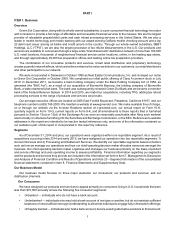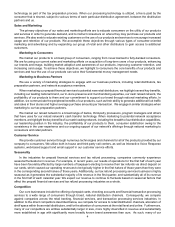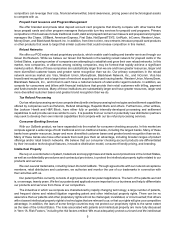Green Dot 2015 Annual Report Download - page 17
Download and view the complete annual report
Please find page 17 of the 2015 Green Dot annual report below. You can navigate through the pages in the report by either clicking on the pages listed below, or by using the keyword search tool below to find specific information within the annual report.11
ITEM 1A. Risk Factors
Risks Related to Our Business
Our operating results may fluctuate in the future, which could cause our stock price to decline.
Our quarterly and annual results of operations may fluctuate in the future as a result of a variety of factors, many
of which are outside of our control. If our results of operations fall below the expectations of investors or any securities
analysts who follow our Class A common stock, the trading price of our Class A common stock could decline
substantially. Fluctuations in our quarterly or annual results of operations might result from a number of factors, including,
but not limited to:
• the timing and volume of purchases, use and reloads of our prepaid cards and other products and services;
• the timing and volume of tax refunds processed by us, including the impact of any general delays in tax refund
disbursements from the U.S. and State Treasuries;
• the timing and success of new product or service introductions by us or our competitors;
• seasonality in the purchase or use of our products and services;
• changes in the level of interchange rates that can be charged;
• fluctuations in customer retention rates;
• changes in the mix of products and services that we sell;
• changes in the mix of retail distributors through which we sell our products and services;
• the timing of commencement, renegotiation or termination of relationships with significant retail distributors
and network acceptance members;
• the timing of commencement of new product development and initiatives that cause us to expand into new
distribution channels, the timing of costs of existing product roll-outs to new retail distributors and the length
of time we must invest in those new products, channels or retail distributors before they generate material
operating revenues;
• our ability to effectively sell our products through online and direct mail marketing initiatives;
• our ability to obtain timely regulatory approval for strategic initiatives;
• changes in our or our competitors’ pricing policies or sales terms;
• significant changes in our risk policies and controls;
• the amount and timing of costs related to fraud losses;
• the amount and timing of commencement and termination of major advertising campaigns, including
sponsorships;
• the amount and timing of costs related to the development or acquisition of complementary businesses;
• the amount and timing of costs of any major litigation to which we are a party;
• the amount and timing of capital expenditures and operating costs related to the maintenance and expansion
of our business, operations and infrastructure, including our investments in a processing solution to replace
our current processing services provider;
• accounting charges related to impairment of capitalized internal-use software, intangible assets and goodwill;
• our ability to control costs, including third-party service provider costs and sales and marketing expenses in
an increasingly competitive market;
• volatility in the trading price of our Class A common stock, which may lead to higher or lower stock-based
compensation expenses; and
• changes in the political or regulatory environment affecting the banking or electronic payments industries
generally or the industries for prepaid financial services and tax refund processing specifically.
























